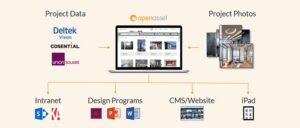How to Calculate Cost Rates for Your Architecture Firm
Jan 9, 2024

This guest post was written by our partner, CMap.
To deliver the types of profitable projects that grow your practice, you first need to understand the cost rates of your fee-earners. In this guide, we’ll go over everything you need to calculate cost rates and ensure maximum profitability.
What Are Cost Rates and Why Are They Important?
Cost rate simply refers to how much an employee costs the company. They’re important because, as an AEC firm, you don’t just sell a service, you also employ staff to deliver that service. So, what you really sell is man-hours. Therefore, it’s important to know the cost of those man hours. This will allow you to extract the maximum amount of profit from every project you deliver.
How to Calculate Cost Rates for Architecture Firms
Without cost rates, there is no way to determine how much it costs your firm to employ your team. Therefore, there’s no way to apply that cost to a quote. However, cost rates are easy to calculate using these three simple steps:
- Set productivity/utilization percentages
- Calculate overhead percentage
- Calculate cost rates
Step 1: Set Productivity Targets for Everyone on Your Team
To calculate accurate cost rates, you first need to have an accurate accounting of the people you employ and their salaries. To do this, create a list of everyone at your firm and each of their salaries.
With your list in hand, you can then assign a productivity/utilization percentage to each name on the list, i.e. the amount of time each employee can commit to billable projects per year.
How to Set Productivity Targets: Part II Architect Example
For example, a Part II Architect with a salary of $28,000/year spends an average of 80% of their time on billable projects in a given year. The other 20% of the Architect’s time accounts for everything that isn’t billable, things like:
- annual leave,
- sickness,
- training days,
- etc..
The next step is to multiply the Architect’s productivity percentage by their annual salary to get the total cost of that employee’s salary that can be recovered on projects. Using the example above, you could expect a Part II Architect to recover $22,400 of their salary in billable project time – $28,000 x 80% = $22,400. The difference of $5,600 is the cost of their non-billable time, which counts as overhead for the business.
Repeat this process with all of the names on your list to find your Total Recoverable Salary figure. The next step is to calculate your Total Overhead figure. Do this by adding the combined non-billable time overhead for all individuals to the cost of your other overheads, like:
- rent,
- bills
- software costs
- pensions
- insurance
- etc.
Step 2: Calculate Overhead Percentage
Following the calculation of the Total Recoverable Salary for everyone at your firm AND the Total Overhead, the next step is to calculate your Overhead Percentage figure. To do this, divide your Total Overhead figure by the Total Recoverable Salary figure.
Total Overhead / Total Recoverable Salary = Overhead Percentage
Your answer will be relative to the scale of your practice and can be anything from 50% to 300%. Let’s say, for example, your Total Overhead figure is $525,000 and your Total Recoverable Salary figure is $480,000, your Overhead Percentage would be 110%.
$520,000 / $470,000 = 110%
Now that you have your Overhead Percentage, you have the variables you need to calculate the cost rate for each individual under your employ.
Step 3: Calculate Cost Rates for Free-Earners
To calculate the cost rate of your free-earners, you divide the salary of each individual at your firm by the number of hours they work per year. The result of that equation is the hourly cost for that individual. It looks like this:
Individual’s Salary (ex: $28,000) / Billable Hours Per Year (ex: 1950 hours) = Individual’s Hourly Salary Cost ( $14.35)
The next step is to add the Hourly Salary Cost ($14.35) to the Overhead figure you calculated earlier for that person ($15.79) to determine the Total Cost Rate for the Individual ($30.14).
Individual’s Hourly Salary Cost ($14.35) + Individual Overhead Figure ($15.79) = Total Cost for Individual ($30.14)
Do the same thing for each individual in your organization to determine an accurate man-hour cost for every individual in your business. Doing so can help you understand which hourly rate you should charge for each member of your fee-earners.
How to Check Your Work/ Ensure Your Calculations Are Correct
To ensure that your calculations are correct, multiply the cost rate of each individual by the total hours spent on projects. The result is an overall figure to recover the cost of the business. The total should equal the total cost of running the practice. If it doesn’t then you’ve done the calculation incorrectly.
Where You Need to Be Careful
There are a few reasons your calculations may be incorrect:
- Productivity targets are actually 10-15% less than what’s been accounted for. The impact of this is that cost rates are too low.
- You forget to recalculate after staff receives a salary increase.
- Fluctuations in staff size mean you either have more people to recover your overheads on, or a reduction in staff means your cost rates will go up.
That’s why it’s important to regularly calculate your cost rates to make sure you can recover overheads whilst still being competitive. Instilling this routine into your diary as a biannual process provides the perfect opportunity to check your staff numbers and salaries. This ensures your rates are consistently accurate.
What’s Next? Download the Free Guide
If you want to learn more about how to ensure maximum profitability download our free guide, where you’ll discover:
- The CMap PETAL Framework for ensuring profitability by eradicating underquoting and over-delivering;
- How to increase profitability in your practice so you can afford more creative freedom;
- How to make quick and easy changes to your processes so that you can identify a costly project early, and
- Ways in which you can make sure your Practice is working efficiently to achieve consistent growth.
Now Put that Knowledge to Good Use: Implement an RFP Process With OpenAsset
Knowing how to calculate accurate cost rates for your firm is incredibly important. Otherwise, you’d have no way to provide accurate quotes or create accurate proposals. Fortunately, you can put the information you learned here to good use by instilling it into your RFP and proposal management process.
With said process in place, the only thing left to do is to implement a digital asset management (DAM) system like OpenAsset. Armed with the info provided here and the power to store, share, and manage the visual elements in your proposals, there will be little to stop the epic rise of your firm to the top of the vendor list. Request a demo with OpenAsset today.





